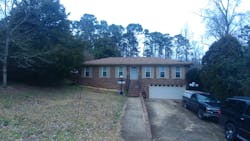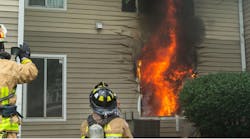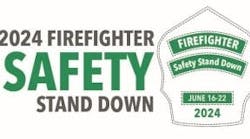Every company officer has been told to do the same thing: Arrive on the scene, give a brief report, and perform a 360-degree survey. What exactly is a 360 survey? Sure, we all know it’s a rapid walk around a scene, but what exactly are we looking for and what procedures should we use to complete it?
Lessons in theory only
Most of us have been taught some acronym or another to perform a scene survey. These acronyms are great for hitting the bullet points on promotional exams, but how do they work on a real scene? Let’s be honest, how many of us walk around a house reciting WALLACE WAS HOT or COAL WAS WEALTH? Others of us were told to “Paint the Picture” of what is happening on the scene. Again I ask: What do we paint?
The 360 survey is one of the few tasks many of us learned only in theory. In every fire officer course, we’re told to complete an on-scene size-up. Every incident management class teaches us that an on-scene survey is a critical part of seeing the big picture. Most of the tasks that are accomplished on an incident scene have been taught in theory as well as in practice. Recruit school teaches us how to perform a task, and that theory is backed with practical hands-on learning. Most of us have been taught things in the fire station, and then we were brought out and shown how to complete the task. Has anyone ever walked with you to show you how to conduct a 360 survey? If so, you’re ahead of the game. If not, then join the club.
Prioritize what’s important
I won’t bore you with another acronym, and it would be impossible to create a comprehensive to-do list of how to perform a 360 survey, but I will offer you a simple method that may work with a little practice.
As you walk around an incident, simply put everything in a mental box. Everything you see, hear, feel, smell, taste or touch should be mentally processed and placed in a box. To start, use two boxes to categorize what you come across: important and not important. That’s it. Nothing more. Is this thing important or not? As you get better at processing the scene, those boxes can be divided into categories, but for now just use the two.
After the items are placed in your mental important box, begin to prioritize them. What is the most important thing in my important box? The things in my not-important box do not need to be prioritized, but they are on your scene so make sure you remember them. These things may become important later.
Many of us were taught an acronym to determine the importance of the items, but I caution you to use acronyms wisely because RECEO VS (Rescue, Exposure, Confine, Extinguish, Overhaul, Ventilate, Salvage) does not cover all the things that need to be processed on an incident scene. Where does the large vicious dog in the back yard fit into RECEO VS? It does not, but it is surely important information that everyone on the scene needs to know. So be careful trying to manage a scene using acronyms; they are tools for your toolbox, but not the be all and end all of an incident.
It’s also important that we learn to move things in and out of these boxes. The large vicious dog that was in my important box has been leashed and walked away by the owner. The dog is still on the scene, so I still have it in a box, but now it has been moved from my important box to my not important box. If the dog escapes from the owner, it will be quickly return to the important box.
Again, it would be impossible to list all the things you could encounter while performing a 360 survey. The important thing is that you process everything into a box. The trees, the grass, the structure, the cars, you name it and it must be mentally processed. Every scene that requires a survey needs everything processed. A tree on a scene might not be very important, but what if it has been raining for days and the tree is noticeably leaning? The tree may not be part of your scene, but it might be very important information.
Sample size-ups
Let’s start with a residential structure fire, processing some things and moving them in and out of our mental boxes. While walking around the structure, you notice a gas can in a covered shed in the backyard. The can is next to a lawn mower so there is nothing strange about it. The can and the lawn mower may be placed in the not important box. As of now they have nothing to do with the incident. After the fire is extinguished, the fire investigator tells you that an accelerant was used and this may be arson. That gas has just changed from not important to very important. Now you would tell the fire investigator what you saw and where you saw it. This could be a critical part of the investigation.
Now let’s walk around a motor vehicle accident that requires a lengthy extrication. During your 360, you notice a car seat that has been ejected from the vehicle. Maybe this is placed in the important box because there is a possibility that a child was ejected from the vehicle. The driver is unconscious so there is no one to ask about the child. This is not only important but it is now high on my priority list of important things. As the incident commander, you have to search for the child, perhaps using the police to assist. During the extrication, the family members of the victim walk up and tell you that the child is safe at home. Now the car seat has been moved from the important box to the not important box. You no longer have to concern yourself with the child or its well-being.
Process everything
We could sit around all day and discuss the things we see, hear, smell, taste, see and touch on an incident scene. The important thing is that we process all the information that our senses tell us and determine if they are important or not. Process everything using all of your senses. A child screaming. Is it part of the scene or are children playing in the backyard of the next door home? The smell of gasoline. Has an accelerant been used or is there a fueling station across the street. If it is important, determine the order of importance and mitigate the things in order. If it is not important, then simply remember those things because they may become important later.
Practice your 360 survey by walking around structures and ask yourself, “What if?” What if this were that? What box would I put it in? Practice moving things in and out of your boxes. Practice on prioritizing your important box. Incident scenes change a lot. Be prepared to change with them.






